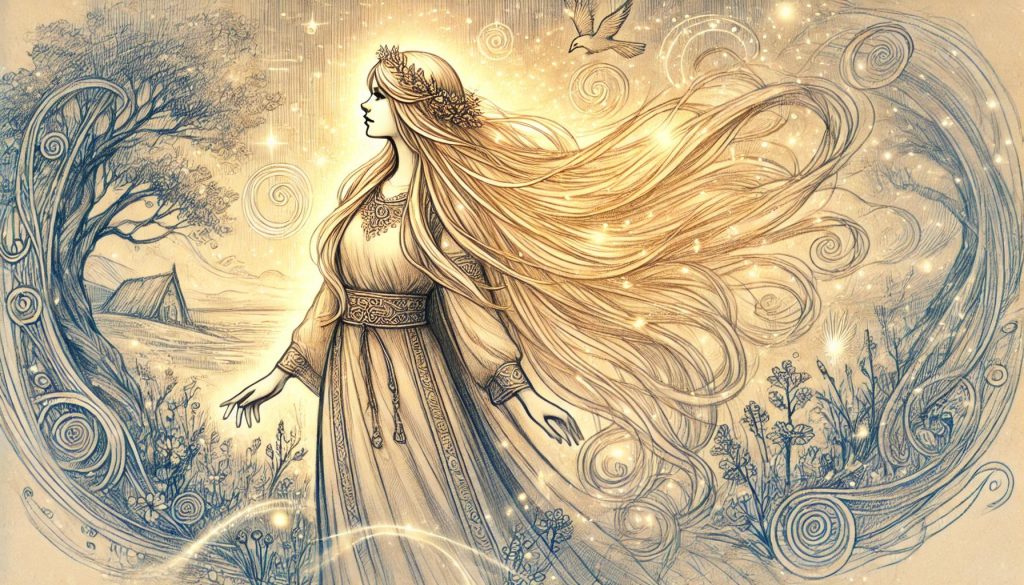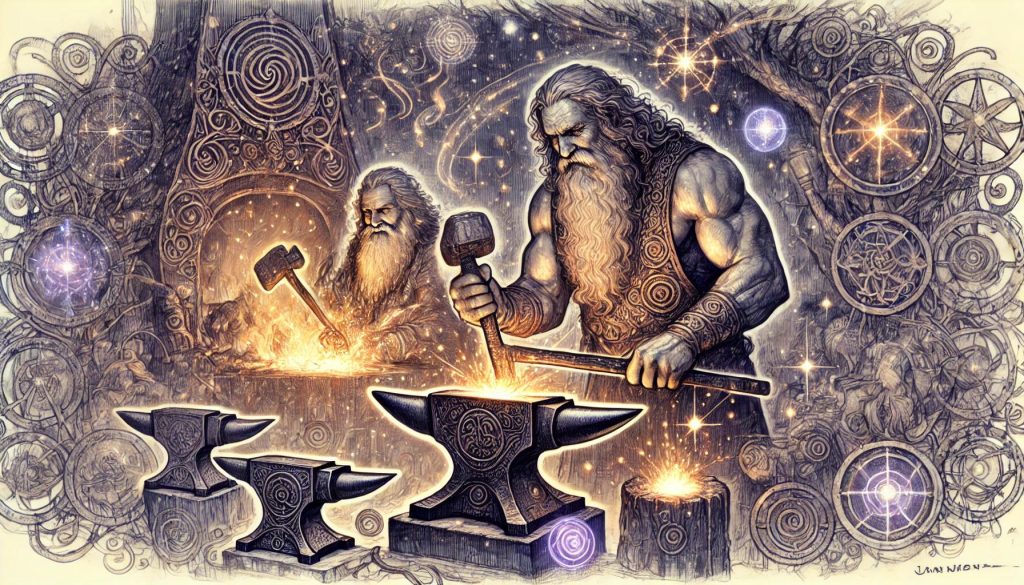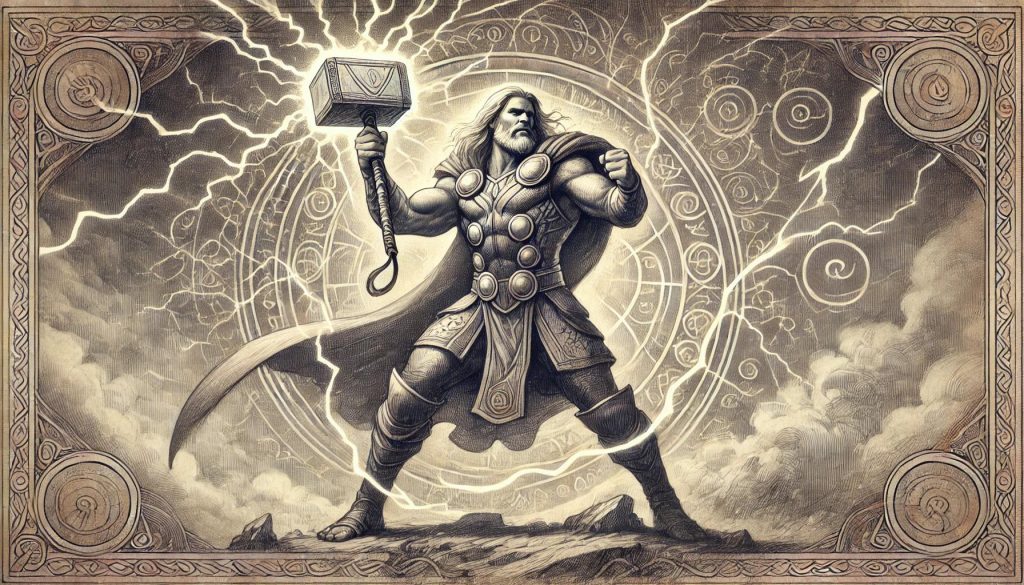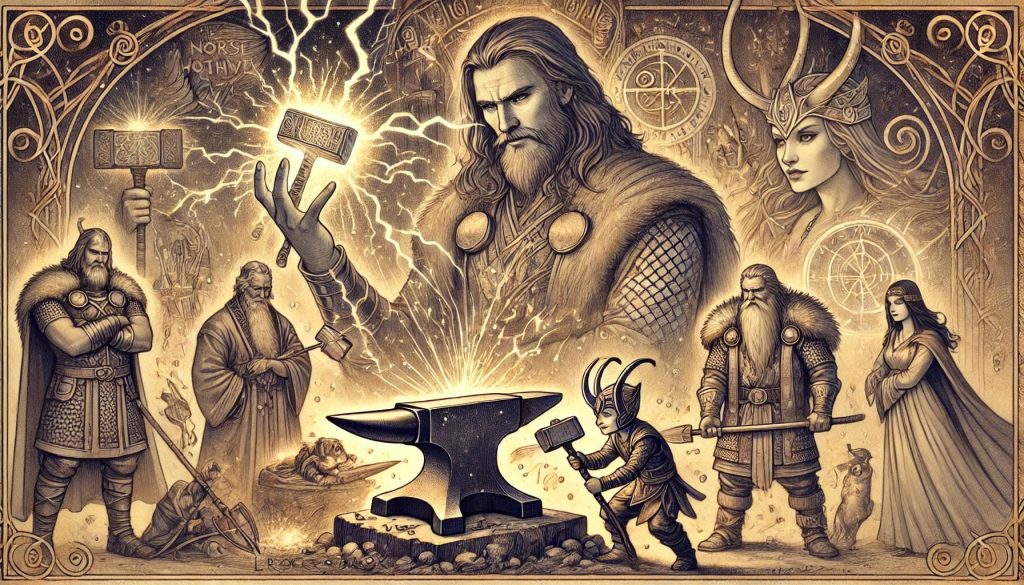Aesir Gods, Mjölnir (Thor’s Hammer), Norse Gods, Norse Mythology, Tales of the Gods, Thor
How Mjolnir Was Created
According to Norse mythology, Mjolnir is the legendary hammer of the thunder god Thor. It’s a powerful weapon and a key symbol of Norse mythology, and it holds a special place in Viking culture.
The story of Mjolnir’s creation is full of intrigue and mischief. It tells of gods, dwarves, and the clever Loki. Join us as we explore the fascinating tale of how Mjolnir was made and the legends that have grown around it.
Introduction
In Norse mythology, Thor is a key god with the powerful hammer Mjolnir. But how did this legendary weapon come to be? We must explore Norse mythology to find out about Mjolnir’s beginnings.
Thor’s wife, Sif, is at the heart of this tale. Her golden hair stands for fertility and wealth. Sif is crucial to the story of Mjolnir’s making, especially with the sacrifice of her hair for Sif.
Ancient texts, like the Edda, help us understand Mjolnir’s creation. They are key to keeping the myths of Norse culture alive and give us deep insights into the gods’ world.
Loki’s Mischief
Loki is known among the Norse gods for his tricks and cunning. His part in making Mjolnir shows his betrayal and deceit. These actions tested the gods of Asgard’s loyalty and creativity.
Loki wanted to be more powerful than the other gods, especially Thor. He knew Mjolnir would be a key symbol of power. So, he decided to help make it, but with his own secret goals.
To achieve his aim, Loki turned to the dwarves Brokkr and Sindri, known for their skill in Svartalfheim. He risked his own head to get them to make Mjolnir and other treasures.
Loki tried to hinder the dwarves’ work with lies and distractions. But the dwarves’ skills won out, and they finished Mjolnir.
But Loki didn’t stop there. As revenge, the dwarves made Gullinbursti a magical boar. This shows how Loki’s actions led to more trouble.
Loki’s role in making Mjolnir shows his true nature. It also reveals the deep themes of loyalty and ambition among the Norse gods. Mjolnir became a key part of Thor’s stories, proving its worth in Norse myths.
The Quest for Redemption
Thor lost his things because of Loki’s tricks. He was determined to prove his strength and get back what was his. He met the clever dwarf brothers, Sindri and Brokkr, on his journey.
The dwarves were key to Thor’s quest. They used their skills to make treasures that helped Thor in his quest for redemption.
Thor’s wife, Sif, with her golden hair, played a big part in the story, which is detailed in the Prose Edda. She gave up her head of hair to make Mjolnir, Thor’s famous hammer. This made the hammer powerful and strong, its magic renewed every ninth night.

Thor’s quest for redemption was closely linked with the dwarves, his strength, Sif’s golden hair, and the journey itself. These elements make the story come alive, highlighting the themes of the Prose Edda. They show the themes of bravery, toughness, and the fight for redemption against hard odds.
The Sons of Ivaldi
The Sons of Ivaldi were famous for their amazing dwarf craftsmanship. They played a big role in Norse mythology. They made magical treasures that were both beautiful and powerful.
One of their most famous items was the golden ring called Draupnir. It was made by the Sons of Ivaldi, who kept their mouth shut throughout the process. This ring could make more copies of itself, creating endless gold. Its beauty and magic made it very sought after, especially the eyelid details.
They also made Gungnir, a spear later used by the god Odin. The Sons of Ivaldi made it with great skill, crafting every part with precision every ninth night. Gungnir was special because it always hit its target and never missed.
The Sons of Ivaldi’s work showed their incredible skills. Their creations were not just beautiful but also very powerful. Their dwarven mastery led to making things that were truly remarkable.
The Bet with Brokkr and Sindri
Sindri and Brokkr, talented dwarf brothers, wanted to make a weapon better than any other. They made a bet to test their skills and see if they could beat the Sons of Ivaldi.
These brothers were famous for their blacksmith skills, amazing work, and attention to detail. They were sure they could make a weapon that would stand out.

The Sons of Ivaldi were also skilled craftsmen, known for making things that made the gods happy, much like the hammer of Thor. Sindri and Brokkr wanted to beat them, so they made a big bet, agreeing to keep their mouth shut while working.
The bet was simple: the brothers had to make three amazing treasures. If they did, they would get a big reward. But if they failed, they would pay a high price.
The first treasure was the boar Gullinbursti, which could move fast on land and in the air. The second was the golden ring Draupnir, which could make more wealth. And the third was the hammer Mjolnir, so powerful it could destroy mountains.
Sindri and Brokkr worked hard on these treasures, putting all their heart into them. The gods were excited to see what they would do next.
But a sneaky force was trying to stop them. This didn’t stop Sindri and Brokkr, though. They kept going, making Mjolnir with all their skill and passion.
Loki’s Sabotage
In the making of Mjolnir, Loki’s actions cause big problems. He’s the god of trickery and loves causing trouble. His actions stop the gods from making the hammer that Thor would later rely on.
Loki waits for the right moment when Sindri, a skilled dwarf, is busy. Then, Loki brings a tiny fly into the room. This fly flies around, distracting Sindri and messing up the work, forcing him to keep his mouth shut to maintain focus.
This little fly seems harmless but actually causes big problems. It makes Sindri’s hands shake, and his focus fades. This is not what was planned for Mjolnir’s creation by the sons of the dwarf Ivaldi.
Making Mjolnir needs total focus and precision. But Loki’s actions bring doubt and mistakes. This messes up Sindri’s work, leading to the imperfect creation of the Hammer of Thor.
Loki’s actions make Mjolnir a powerful but unpredictable tool, creating trouble every ninth night. This shows how Loki’s chaotic nature affects the weapon.
Loki’s actions show how close order and chaos are. The gods wait for Mjolnir, not knowing about Loki’s role. They don’t see the risks Mjolnir might bring.
The Creation of the Treasures
In the fiery forges of the dwarven realm, Mjolnir was made with great care. This showed off the dwarves’ unmatched skill in crafting. Their work is famous across the realms.
In Svartalfheim’s sacred halls, dwarven blacksmiths worked hard. They mixed skill and magic into their work. They shaped enchanted metals and added powerful spells to create the great hammer.
Mjolnir was made from the best magical materials. The dwarves used iron from distant stars and a secret alloy. This made Mjolnir incredibly strong and magical, a true powerhouse.
Every part of Mjolnir was made with thought. Its short handle was a thoughtful choice. The dwarves made it that way, knowing the wielder’s grip would unlock its full power. The short handle showed the skill needed to wield it right.
As the forges blazed, the dwarves put their all into Mjolnir. With every hammer strike, their craftsmanship echoed through the halls. This created a weapon that went beyond all expectations, a true force to be feared.
Mjolnir was made using a blend of dwarven skill, magical materials, and careful work. These things gave it unmatched power and a godly aura, making it a revered weapon in the Prose Edda. The dwarves’ artistry made Mjolnir a lasting symbol of their greatness, especially praised in Old Norse texts.
The Presentation to the Gods
Sindri and Brokkr brought their amazing creations to the gods. Everyone was excited to see what they had made. The gods came together to see the new treasures.
The gods were amazed by what they saw. Mjolnir, Thor’s hammer, was the main attraction, its design perfected by two dwarves. They knew it would give Thor great power.
When Thor accepted Mjolnir, a special bond formed between them. Holding the hammer, Thor felt incredibly powerful, ready for any battle as the god of war. This showed he was the only one worthy to use the Hammer of Thor.
The gods saw how important Mjolnir was. They knew it showed Thor’s strength and the gods’ power together, gaining more admiration every ninth night. With Mjolnir, Thor could protect Asgard from danger.
Presenting Mjolnir to the gods made Thor a powerful warrior every ninth night. It also showed how the gods work together. They realized their strength combined would keep their realms safe.
This moment was key in Norse mythology. It made Mjolnir a symbol of the gods’ power. Thor’s acceptance of it showed their commitment to protecting the Nine Realms.
Mjölnir’s Importance and Legacy
In Norse mythology, Mjölnir is a key part of Thor’s story. It’s his legendary hammer and a symbol of his power. This hammer is famous for its strength and plays a big role in Thor’s identity.
For Thor, Mjölnir is more than a weapon. It’s a sign of his strength and his duty to protect Asgard and the mortal world. It can control the weather and deal massive damage, showing Thor’s strength and his role as a protector, especially in the events leading to Ragnarök.

Marvel comics have made Mjölnir even more famous. They show Thor as a superhero with this powerful hammer. This has made Thor a favorite in the Marvel world.
Mjölnir, the Hammer of Thor, also has a special place in Norse pagan traditions. In these beliefs, it was seen as a tool of Thor’s protection and a sign of good luck. It was thought to bring blessings and keep evil away, symbolizing strength and divine support.
Today, Mjölnir’s story goes beyond myths and comics. It connects to the idea of Ragnarok, the end of the world. This shows the hammer’s role in the cycle of creation and destruction. It’s seen as a symbol of hope for a new beginning after the end.
In the end, Mjölnir’s impact is huge. It stands for Thor’s strength, bravery, and his duty to protect. Marvel comics have won the hearts of many fans. Its ties to Norse traditions and Ragnarok highlight its lasting effect on stories and culture.
Conclusion
The story of Mjolnir’s creation is full of craftsmanship and deceit. The Sons of Ivaldi made this legendary hammer with great skill. But Loki, the trickster, changed its final look.
The gods went through many trials to make Thor’s hammer, including contributions of Sif’s hair. Loki tried to stop them, but their hard work won out. This story shows that skill and hard work beat deceit.
Thor’s Hammer’s story lives on in Norse mythology and Viking culture. It’s more than a powerful weapon; it’s a symbol of strength and protection. It shows the strong bond between gods and humans.
This tale ends with a look at craftsmanship and the effects of deceit. Thor’s hammer, Mjolnir, shows the lasting power of our ancestors’ stories.

